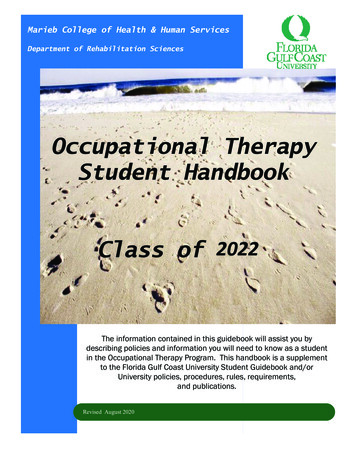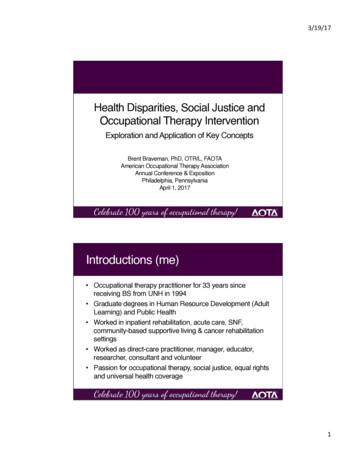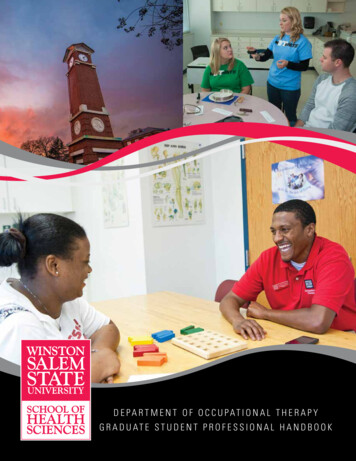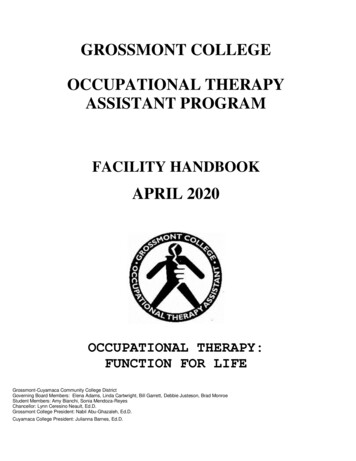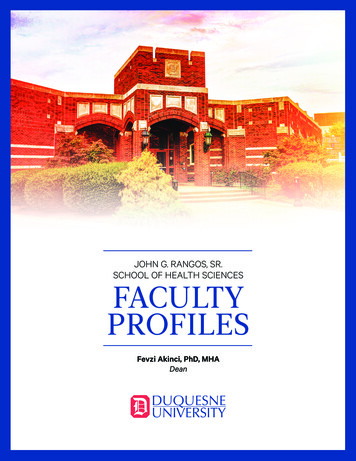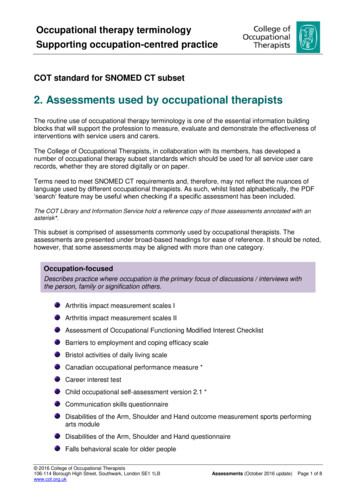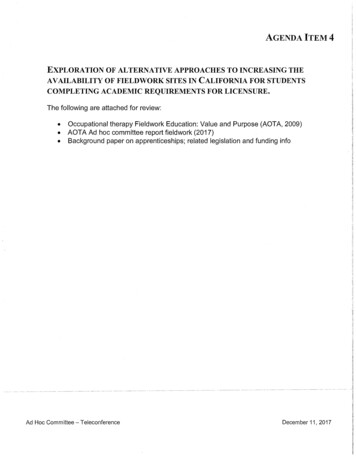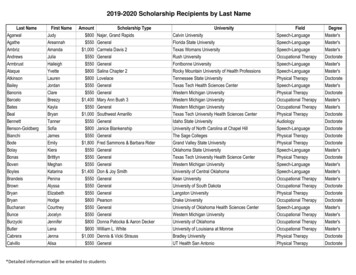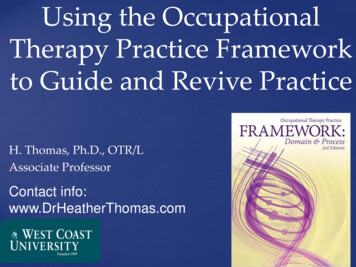
Transcription
Using the OccupationalTherapy Practice Frameworkto Guide and Revive PracticeH. Thomas, Ph.D., OTR/LAssociate ProfessorContact info:www.DrHeatherThomas.com
Objectives1) Identify and apply the terminology used within thedomain and process of the Occupational TherapyPractice Framework2) Understand the interrelationship between the domainand process in the Framework.3) Recognize how to utilize the Framework to reviveone’s own practice.
Evolution of The OT Practice FrameworkCreated by the American Occupational TherapyAssociation- The first edition: 2002 The Occupational Therapy Practice Framework, 3rdEdition: 2014 What we do (Domain)&How we do it (Process)
Where Can I Get It? For FREE:http://ajot.aota.org/article.aspx?articleid 1860439Or purchase:https://myaota.aota.org/shop aota/prodview.aspx?Type D&SKU 900361& ga 1.76375773.934713774.1423103651
Defining CurrentOccupational TherapyDomainProcess Ourprofessionalexpertise Actions taken How“Achieving health, wellbeing, and participationin life throughengagement inoccupation “(AOTA, 2014, S4)
Domain ofOTWhat do we look at ?What do we careabout?
Occupational Therapy’s Domain
The Areas of OccupationTable 1 of OTPF: Occupations 8 (areas of) occupation This classification of occupations helps by: Clarifying our scope of practice- for us and others! Serving as a cue for practitioners Giving examples of what may be in an occupation
The 8 Areas ofOccupation-Activities of Daily Living (ADL)-Instrumental Activities of Daily Living(IADL)-Rest and sleep-Education-Work-Play-Leisure-Social participation
Activities of Daily Living(ADL)“Taking care ofone’s own body” (AOTA, 2014)
9 Categories Under ADLBathing/showering Dressing Swallowing/eating Feeding Functional mobility
9 Categories Under ADL(cont.)Personal device care Hygiene and grooming Sexual activity Toileting and toilet hygiene
12 Categories Under IADL Care of othersCare of petsChild rearingCommunication managementDriving and CommunitymobilityFinancial management
12 categories under IADL (cont.) Health management & maintenanceHome establishment &managementMeal preparation & cleanupReligious and spiritual activities andexpression (observance)Safety & emergency maintenanceShopping
Rest and SleepRest Sleep Preparation Sleep Participation
EducationFormal education participation Informal personal educationalneeds/interests exploration Informal personal educationparticipation
WorkEmployment interests and pursuits Employment seeking and acquisition Job performance Retirement preparation andadjustment Volunteer exploration Volunteer participation
PlayPlay exploration Play participation
LeisureLeisure exploration Leisure participation
Social Participation Community Family Peer, friend
Occupational Therapy’s Domain
Client FactorsWhat are “client factors”?RESIDE WITHIN THE CLIENT-Values, Beliefs, and Spirituality Body Functions Body Structures
Client Factors Body Functions Categories:Specific mental functions Global mental functions Sensory Functions Neuromusculoskeletal and movement related Muscle functions Movement functions Cardiovascular, hematological immunological, andrespiratory Voice & speech functions; digestive, metabolic andendocrine functions; genitourinary & reproductive Skin & related structure
How does this apply to mypractice setting?What client factors do you assess? What client factors do you considerwhen determining limitations inengagement in occupations? Are you considering all of these aselements demanded of activities?
Occupational Therapy’s Domain
Performance Skills “Goal-directed actions” Performance skills are observable, concrete. Small units of activity or engagement Developed over time
Performance SkillsMotorProcessSocial Interaction
Motor ratesFlowsEnduresPaces
Motor SkillsAlignsStabilizesPositionsRelated to bodyposition
Motor ed to obtainingand holding objects
Motor ted to moving selfand objects
Motor SkillsEnduresPacesRelated to sustainingperformance
Process sAdjustsAccommodatesBenefits
Process SkillsPacesAttendsHeedsRelated to energy
Process SkillsChoosesUsesHandlesInquiresRelated to applyingknowledge
Process SkillsInitiatesContinuesSequencesTerminatesRelated to temporalorganization
elated to organizingspace and objects
Notices/respondsAdjustsAccommodatesBenefitsRelated to adaptingperformance
Social Interaction SkillsApproaches/ startsConcludes/disengagesProduces speechGesticulatesSpeaks fluentlyTurns towardLooksPlaces sses emotionDisagreesThanksTransitionsTimes responseTimes durationTakes turnsMatches languageClarifiesAcknowledges and encouragesEmpathizesHeedsAccommodatesBenefits
Social Interaction SkillsApproaches/ startsConcludes/disengagesProduces speechRelated to initiatingand terminating socialinteraction
Social Interaction SkillsProduces speechGesticulatesSpeaks fluentlyRelated toproducing socialinteraction
Social Interaction SkillsTurns towardLooksPlaces selfTouchesRegulatesRelated to physicallysupporting social inter.
Social Interaction SkillsQuestionsRepliesDisclosesExpresses emotionDisagreesThanksShaping the content ofsocial interaction
TransitionsTimes responseTimes durationTakes turnsRelated to maintainingflow of social interact.
Matches languageClarifiesAcknowledges and encouragesEmpathizesRelated to verballysupporting socialinteract.
HeedsAccommodatesBenefitsRelated to adapting tosocial interaction
How does this apply tomy practice area?Are you assessing these performanceskills? Are you helping to establish these skills? Help to adapt for decreased skill?
Performance PatternsPatterns of behavior that are habitual or routineHabits: Automatic behaviors- can be useful,dominating or impoverished Routines: Patterns of behavior Rituals: Symbolic actions Roles: Set of behaviors expected
How does this apply tomy practice?Are you assessing theseperformance patterns? Are these patterns influencing yourclient’s engagement? Are your own routines or habitsinfluencing your practice?
Context & Environment Conditions that surround the client Some are external: Physical, social,virtual, cultural, temporal Some are internal: Personal Can inhibit or promote performance
ContextsCultural Personal Temporal Virtual EnvironmentsPhysical Social
How does this apply tomy practice? Evaluate contexts- they either hinderor support engagement Address contexts in intervention Practice contexts
Process
Process: EvaluationOccupational Profile Analysis of Occupational Performance
Occupational ProfileIdentify the following: Why is the client seeking service, and what are the client’scurrent concerns relative to engaging in activities andoccupations? In what occupations does the client feel successful, andwhat barriers are affecting his or her success? What aspects of the contexts or environments does the clientsee as supporting and as inhibiting engagement in desiredoccupations? What is the client’s occupational history? What are the client’s values and interests? What are the client’s daily life roles? What are the client’s patterns of engagement in occupations,and how have they changed over time?
Print out and start usingthis with EVERY client! https://www.aota.org/ on/AOTAOccupational-Profile-Template.pdf
Analysis of OccupationalPerformanceUse information from occupationalprofile Gather data using assessments: what isimpacting occupational performance? Focus assessment and subsequentintervention plan based on DOMAIN
Outcomes Occupational PerformanceImprovement Enhancement Prevention Health and Wellness Quality of Life Participation Role Competence Well-being Occupational Justice
Interventions TypesOccupations & Activities Occupations Activities Preparatory Methods &Tasks Splints Assistive Technology Wheeled mobility Preparatory tasks Education & Training Education Training Advocacy Advocacy Self-advocacy Group Interventions
ApproachesCreate/promote Establish/restore Maintain Modify Prevent
Conclusion The OTPF provides a framework from whichto define what we do- THIS IS WHO WE ARE It helps us define OT to others It reminds us of what we are to do- fromevaluation to intervention to discontinuation It reflects the expanding areas of ourprofession
References American Occupational Therapy Association.(2014).Occupational therapy practiceframework: Domain and process (3rd ed.).American Journal of Occupational Therapy,68(Suppl.1), 6 Butts, D. & Nelson, D. (2007). Agreement between Occupational Therapy PracticeFramework classifications and occupational therapists’ classifications. American Journal ofOccupational Therapy, 61(5), 512-518. Gutman, S., Mortera, M., Hinojosa, J.& Kramer, P. (2007). Revision of the OccupationalTherapy Practice Framework. American Journal of Occupational Therapy, 61(1), 119-126. Thomas, H. (2015). Occupation-based activity analysis. Thorofare, NJ: Slack. Youngstrom, M. (20012). The Occupational Therapy Practice Framework: The evolution ofour professional language. American Journal of Occupational Therapy, 56(6), 607-608.
Contact:www.DrHeatherThomas.com
Volunteer exploration . The Occupational Therapy Practice Framework: The evolution of our professional language. American Journal of Occupational Therapy, 56(6), 607-608. Ref
